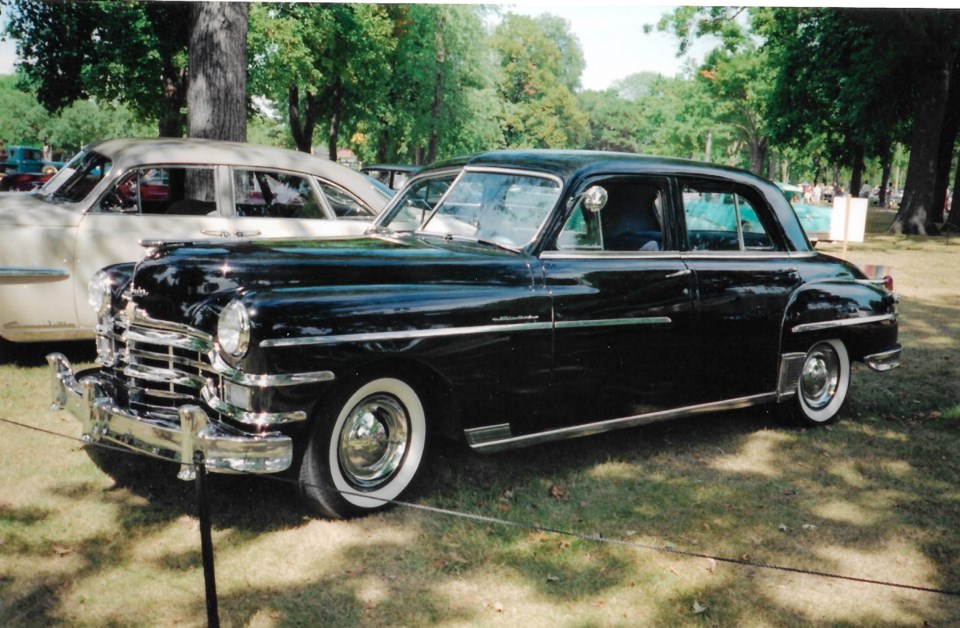Nineteen forty-nine was an important year for the North American automobile industry. It marked the arrival of all-new post Second World War styling from the Big Three (General Motors, Ford and Chrysler) with the exception of a couple of 1948 General Motors models.
Although smaller manufacturers Hudson and Studebaker had been quicker with new models, they represented a relatively small percentage of the market.
Chrysler Corp. was a little slower than GM and Ford in introducing new styling, carrying its 1948 designs into the first half of 1949. When their newly styled “second series” ’49s did arrive in mid-1949, they were a disappointment to some.
While the lines of GM and Ford cars looked smart and modern, Chrysler’s appeared tall and boxy. They were rugged and substantial, but in a more stately formal way compared with the competition’s daring lines.
Perhaps Chrysler was still smarting from the poor acceptance of the swoopy Art Deco mid-1930s styled Chrysler and DeSoto Airflows. Although technically advanced, their styling did not have wide appeal.
But the main inspiration for the staid 1949 Chrysler styling came right from the corporate boardroom, K.T. Keller, Chrysler’s no-nonsense president who had taken over from founder Walter Chrysler in 1935.
He shunned what he saw as fads, favouring instead tall, roomy cars that a man could easily enter and exit while wearing a fedora. This was exemplified in the 1949 Chrysler. While its heft and solidity projected a sturdy appearance, it lacked a certain styling panache.
Chryslers had massive grilles comprised of two heavy horizontal bars punctuated by smaller vertical strips. This strong appearance was crowned by a bumper of robust proportions.
The trunk lid was dominated by a chromed licence-plate holder incorporating the turn signals, backup lights and trunk handle. Fender-mounted tail-lights had little kick-ups almost reminiscent of the Cadillac’s 1948 tailfins. An equally imposing rear bumper wrapped around from wheel to wheel.
Under the hood was either the 4.1-litre, 116-horsepower, inline side-valve six or the veteran 5.3-litre, 135-horsepower side-valve straight eight.
These were decidedly old fashioned engines compared with the new short-stroke, overhead valve V-8s found in 1949 Oldsmobiles and Cadillacs. Chrysler’s fabulous overhead valve “Hemi” V-8 was still a couple of years in the future.
The Chrysler came in four series: six-cylinder Royal and Windsor, and eight-cylinder Saratoga and New Yorker.
There was also a Town & Country convertible, a sub-series of the New Yorker with “woody” sides, although the real mahogany veneer had been replaced by decals a couple of years earlier.
At the top of the line reigned the massive New Yorker-based Imperials and Crown Imperials, which sold in limited numbers. They had disc brakes, although not caliper type, but with stationary discs pressing outward against a spinning housing.
Tiny Crosley pioneered the now universal caliper-type discs, also in 1949.
Chrysler sent power through what it called Presto-Matic (formerly Fluid Drive) transmission in which a fluid coupling replaced the flywheel. There was a conventional clutch, but the fluid coupling allowed the car to be driven without using it. The clutch was required for shifting between low and high range and for reverse.
While Presto-Matic did mostly eliminate gear shifting, it gave ponderously slow acceleration. But at least it dipped Chrysler’s toe into the clutchless driving water, although much less effectively than GM’s Hydra-Matic.
A small but significant advance made by the Chrysler Corp. in 1949 was the introduction of key-turn starting. It was a welcome change that reduced starting from two operations to one.
Chrysler engineers also waterproofed the ignition system more effectively in an attempt to overcome Chrysler products’ notorious susceptibility to dampness.
The interior of the Chrysler was somewhat baroque, with a huge three-spoke steering wheel and chrome horn ring dominating the driver’s compartment. The large, round, hooded speedometer was flanked on its periphery by gauges for amps, fuel level, oil pressure and coolant temperature.
A lavish use of chrome gave the instrument panel a decidedly juke-box appearance, although it had the safety of a padded dash.
In our era of austere Germanic interiors and jellybean-shaped exteriors, it would be easy to dismiss the ’49 Chrysler today. That would do it a disservice. It had elegance and a coddling quality not found in today’s cars. Its much admired interior was clearly in step with the times.
Chrysler Corp. would get back on the styling bandwagon with its new 1955 “Forward Look” cars. It then went absolutely outré in ’57 with huge tailfins that out-finned Cadillac.
But from 1949 to ’54 Chrysler lived through a period during which its cars, while appearing imposing and substantial, would not be counted as triumphs of styling. But they were easy to enter and leave.



